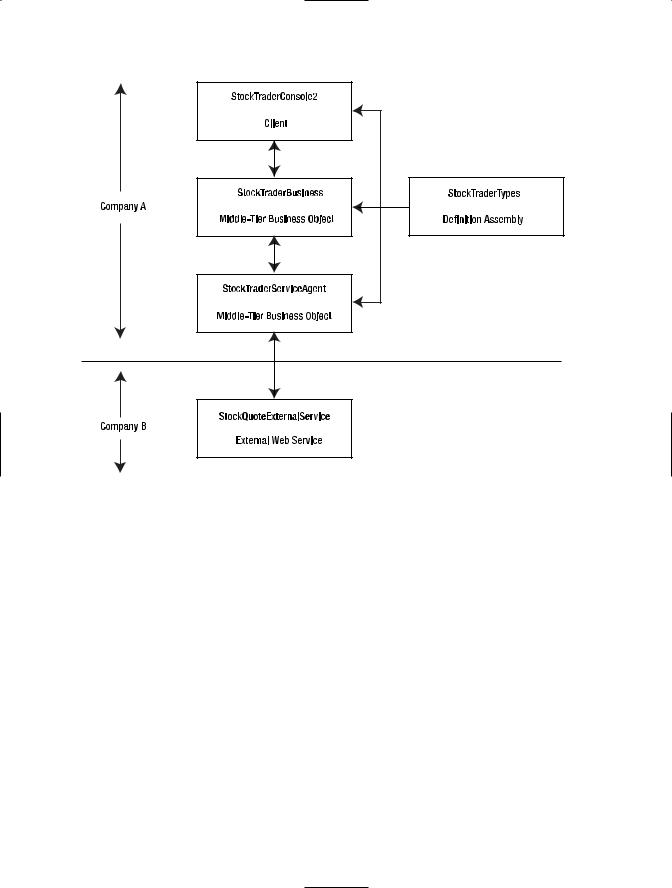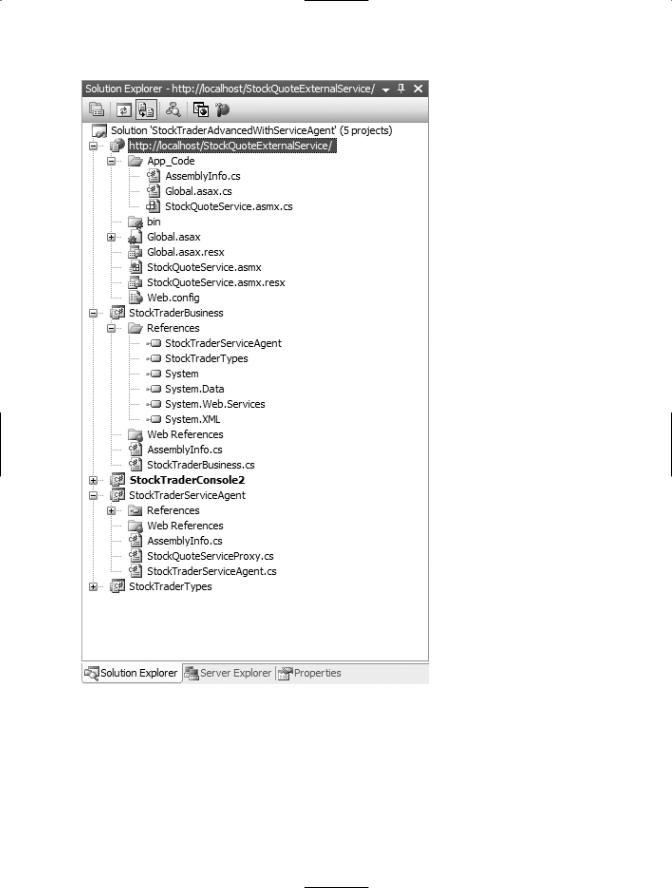
Expert Service-Oriented Architecture In CSharp 2005 (2006) [eng]
.pdf
76 C H A P T E R 4 ■ D E S I G N PAT T E R N S F O R B U I L D I N G S E R V I C E - O R I E N T E D W E B S E R V I C E S
Figure 4-6. SOA with a service agent
Now let’s look at how you implement this architecture in code.
Implement the StockTrader SOA Application Using a
Service Agent
The StockTrader Web service has evolved in this chapter to where it delegates all requests to a business assembly (StockTraderBusiness). If a client contacts the Web service to request a stock quote, the Web service delegates the request to the business object’s RequestQuote method. The Web service does not know or care how this method returns a stock quote, but it does expect to receive one every time it makes a request.
For the next evolution of the StockTrader Web service, your company signs a partnership agreement with another company that is a premier provider of stock quotes. You decide that going forward the StockTraderBusiness assembly will delegate all stock quote requests to this external service. The StockTrader Web service will continue to delegate requests to the business assembly, but the business assembly, in turn, will delegate the requests again, this time to an external Web service. You decide to build a service agent to minimize any change to the business assembly. Figure 4-7 shows the Solution Explorer for the solution that you are going to build, with selective References nodes expanded so you can see the relationships between the different components.

C H A P T E R 4 ■ D E S I G N PAT T E R N S F O R B U I L D I N G S E R V I C E - O R I E N T E D W E B S E R V I C E S |
77 |
Figure 4-7. Solution Explorer for the StockTrader SOA application, including a service agent
The five components in this application are as follows:
1.StockTraderConsole2: The client application, providing a user interface
2.StockTraderBusiness: The middle-tier business component that handles processing for the client

78C H A P T E R 4 ■ D E S I G N PAT T E R N S F O R B U I L D I N G S E R V I C E - O R I E N T E D W E B S E R V I C E S
3.StockTraderServiceAgent: The service agent used by the business component for communicating with external services
4.StockTraderTypes: The common type definition assembly, which is referenced by the three preceding components
5.StockQuoteExternalService: The external Web service
If this gets confusing, you can consult either Figure 4-6 or Figure 4-7, which include all five of these components. Let’s look at how to build each component in turn, going from bottom to top, in the order of the service request workflow, starting with the external StockQuoteExternalService Web service.
The External Web Service (StockQuoteExternalService)
StockQuoteExternalService is a simple Web service that provides a single Web method for requesting stock quotes (RequestQuoteExt), and it returns its own equivalent to the StockTraderTypes.Quote type, which is named QuoteExt. The Quote and QuoteExt types are equivalent, but they differ from each other in three ways:
1.The QuoteExt type conforms to a different qualified namespace from the Quote type. Each type conforms to its own XSD schema file.
2.The QuoteExt type does not contain equivalents to the Quote type’s Change and Percent_Change properties.
3.The QuoteExt type provides a time stamp property named DateTime_Ext, which is of type System.DateTime. The Quote type provides an equivalent time stamp property named DateTime that is of type String.
These are admittedly minor differences, but they illustrate the point. When you call an external service, it is unlikely that their type definitions will be equivalent to yours. You have to be prepared for some manual work to translate the differences.
In real life, of course, you would not have to create the external service yourself, but for the purposes of this demonstration you do.
The Service Agent (StockTraderServiceAgent)
The service agent implements the same interface and type definitions as the business assembly by referencing the StockTraderTypes assembly (as shown in Figure 4-6). The service agent also includes a proxy class for the StockQuoteExternalService external Web service.
Listing 4-9 shows the code listing for the service agent, including the complete listing for its RequestQuote method.

C H A P T E R 4 ■ D E S I G N PAT T E R N S F O R B U I L D I N G S E R V I C E - O R I E N T E D W E B S E R V I C E S |
79 |
Listing 4-9. The StockTraderServiceAgent Code Listing
using System;
using StockTraderTypes;
namespace StockTraderServiceAgent
{
public class StockTraderServiceAgent : StockTraderTypes.IStockTrader
{
public StockTraderServiceAgent(){}
public Quote RequestQuote(string Symbol)
{
Quote q = null;
//Request a Quote from the external service QuoteExt qe;
StockQuoteService serviceProxy = new StockQuoteService(); qe = serviceProxy.RequestQuoteExt("MSFT");
//Create a local Quote object (from the StockTraderTypes namespace) q = new Quote();
//Map the external QuoteExt object to the local Quote object
//This requires some manual work because the types
//do not map exactly to each other
q.Symbol = Symbol; q.Company = qe.Company_Ext;
q.DateTime = qe.DateTime_Ext.ToString("mm/dd/yyyy hh:mm:ss"); q.High = qe.High_Ext;
q.Low = qe.Low_Ext; q.Open = qe.Open_Ext; q.Last = qe.Last_Ext;
q.Previous_Close = qe.Previous_Close_Ext; q.Change = (qe.Last_Ext - qe.Open_Ext); q.PercentChange = q.Change/q.Last; q.High_52_Week = qe.High_52_Week_Ext; q.Low_52_Week = qe.Low_52_Week_Ext;
return q;
}
public Trade PlaceTrade(string Account, string Symbol, int Shares, Double Price, TradeType tradeType)
{
// Implementation not shown
}

80 C H A P T E R 4 ■ D E S I G N PAT T E R N S F O R B U I L D I N G S E R V I C E - O R I E N T E D W E B S E R V I C E S
public Trades RequestAllTradesSummary(string Account)
{
// Implementation not shown
}
public Trade RequestTradeDetails(string Account, string TradeID)
{
// Implementation not shown
}
}
}
The code listing is very straightforward and shows how the service agent delegates its RequestQuote method to the external service’s RequestQuoteExt method. The service agent performs some manual translations to map between its native Quote type and the external QuoteExt type. Finally, the agent returns a native Quote object to the consuming application, which in this case is the business assembly.
The Business Assembly (StockTraderBusiness)
The business component sets references to both the service agent assembly and the definition assembly of custom types. Listing 4-10 shows how the business component calls the service agent.
Listing 4-10. The StockTrader Business Component Calling the Service Agent
using System;
using StockTraderTypes;
using StockTraderServiceAgent;
namespace StockTraderBusiness
{
public class StockTraderBusiness : StockTraderTypes.IStockTrader
{
public StockTraderBusiness() {}
public Quote RequestQuote(string Symbol)
{
//Create a new Quote object Quote q = new Quote();
//Call the service agent
StockTraderServiceAgent sa = new StockTraderServiceAgent(); q = sa.RequestQuote(Symbol);

C H A P T E R 4 ■ D E S I G N PAT T E R N S F O R B U I L D I N G S E R V I C E - O R I E N T E D W E B S E R V I C E S |
81 |
return q;
}
}
}
As you would expect, the listing is very simple because the business assembly no longer has to provide its own implementation of the Quote request logic.
In summary, service agents are an elegant solution when you need to interface with one or more external services and wish to isolate the code that handles the communication. Service agents provide stability to a business assembly by bearing the responsibility of ensuring successful calls to external services and returning results in a form that the business assembly natively understands. Service agents can also act as intermediaries between two or more Web services.
This concludes the discussion of how to build basic service-oriented Web services.
Summary
In this chapter, we expanded on the previous discussion of message-oriented Web services and showed you a six-step process for designing and building a service-oriented Web service from scratch:
Step 1: Create a dedicated type definition assembly.
Step 2: Create a dedicated business assembly.
Step 3: Create the Web service using the type definition assembly.
Step 4: Implement the business interface in the Web service.
Step 5: Delegate processing logic to the business assembly.
Step 6: Create a Web service client.
You saw how to build both tightly coupled clients and loosely coupled clients. In most SOA applications you will want to build loosely coupled clients, but under some circumstances you may want a higher level of control over the type definitions. Tightly coupled clients reference the same type definition as the assembly rather than generating their own using a proxy class.
Finally, we discussed the service agent component, which is a special feature of serviceoriented applications. The service agent manages communication between a business assembly and an external Web service. It can also act as the intermediary between two or more Web services.
The goal of this chapter is to help you rethink your approach to Web services design so that you can start thinking in terms of SOA.


C H A P T E R 5
Web Services
Enhancements 3.0
Web services technology has evolved rapidly since its debut a few years ago. Businesses were initially reluctant to fully adopt the technology because of a lack of industry-standard specifications to govern such important issues as message security and reliable delivery. Businesses will not send sensitive information across the wire if it is vulnerable to detection. And they will not implement large-scale distributed systems with this technology if the reliability of the messages cannot be guaranteed.
This chapter lays the groundwork for the second half of the book, where we will focus intensively on how to implement WSspecifications using Microsoft’s Web Services Enhancements 3.0 for .NET. This chapter includes the following:
•Overview of the WSspecifications
•Introduction to Web Services Enhancements (WSE) 3.0
•Installing and configuring WSE 3.0, including the test certificates
•Using the WSE 3.0 utilities
This chapter is a must-read in order to get the most out of the second half of the book. It will help you to understand the WSspecifications and how WSE fits into the context of SOA. It will also get you started with installing and configuring WSE 3.0, including the test certificates, which are required for many of the code samples.
Overview of the WSSpecifications
Web services technology was initially tailored toward point-to-point communication, based on the familiar HTTP request/response model in which a client request generates a timely server response. This model works well for Internet browsing, but it proves to be very limiting for distributed service applications. Web services that are involved in business processing cannot always generate a timely response. The business process may be long-running, or a required back-end system may be offline.
In addition, the point-to-point communication model proves to be overly limiting for executing complex distributed business processes. It is unlikely that one Web service has the ability to execute a business process 100 percent of the time. More likely it needs to interact
83

84C H A P T E R 5 ■ W E B S E R V I C E S E N H A N C E M E N T S 3 . 0
with other systems and perhaps even with other Web services. Clearly, it is a problem if a Web service receives a request message but is then unable to forward it on to other services for additional processing.
Industry leaders have been working together for several years to address the current limitations with Web services technology. Standards committees have formed to bring a sense of order to the wide variety of available technologies and versions. In Chapter 1, we discussed the WS-I Basic Profile, which outlines a set of Web-related technologies by version number and groups them together into a standard profile. You are considered to be in compliance with this standard if you are implementing the exact technology versions in this profile. In addition, nonprofit organizations such as OASIS are important forums where companies
are actively cooperating in the development and advancement of new standards and specifications.
Companies, including Microsoft, IBM, BEA Systems, and VeriSign, are working on a set of specifications called the Web service specifications (WS-*) that are based on XML, SOAP, and WSDL extensibility models. Together these specifications define a set of composable features to make Web services “secure, reliable, and transacted,” as the standard tag line often reads.
Composability refers to the fact that you can pick and choose the selected specifications that apply to your particular business scenario. None of the specifications are ever required, even the security specifications, though as they become more widely accepted, it is likely that a subset of the specifications will be required in any robust, business-quality Web service.
Business Significance of the WSSpecifications
The WSspecifications are incredibly important to the future of Web services technology and to SOA. Microsoft provides a set of tools for .NET called Web Services Enhancements (WSE). WSE includes managed APIs for implementing selected WSspecifications in a composable manner. We say selected because the WSspecifications continue to evolve, and it will take time for all of the current standards to be submitted, accepted, and then incorporated into WSE. New WSspecifications continue to be released, so the future promises to hold many interesting and important developments in this evolving technology.
The purpose of the WSspecifications is to establish a set of standards for enterpriselevel, service-oriented Web services. The focus of the specifications is on Web services in general, and on messages in particular, because messages are the essential aspects of an SOA. Without messages, Web services cannot communicate. And without secure, reliable messages, businesses will never trust that they can send sensitive information between Web services. The integrity of the message is the key to gaining acceptance for Web services as a robust business solution.
Each of the WSspecifications addresses a different business-critical issue. For example, WS-Security addresses how to implement digital signing and encryption technology in Web services. WS-Reliable Messaging addresses how to ensure that messages are always delivered, even if one part of the system is temporarily unavailable. Each specification is recorded directly in the header of the applicable SOAP message, using a dedicated XML schema. Some specifications, such as WS-Security, also modify the body of the SOAP message for encryption.
Listing 5-1 shows one example of a SOAP message that implements multiple specifications, including WS-Addressing, WS-Security, and WS-Reliable Messaging. Notice that the message header is divided into distinct parts and that the individual specification schemas

C H A P T E R 5 ■ W E B S E R V I C E S E N H A N C E M E N T S 3 . 0 |
85 |
do not overlap. This is known as composability because the individual specifications may be added or removed from the message header as needed.
Listing 5-1. SOAP Message Illustrating Web Service Composability
<s:Envelope xmlns:S="http://www.w3.org/2002/12/soap-envelope" xmlns:wsa=http://schemas.xmlsoap.org/ws/2003/03/addressing
xmlns:wsse=http://schemas.xmlsoap.org/ws/2003/03/security
xmlns:wrm="http://schemas.xmlsoap.org/ws/2003/03/reliablemessaging">
<s:Header>
<!--WS-Addressing --> <wsa:From>
<wsa:Address>http://www.bluestonepartners.com/Buyer</wsa:Address>
</wsa:From>
<wsa:ReplyTo>
<wsa:Address>http://www.bluestonepartners.com/Broker</wsa:Address>
</wsa:ReplyTo>
<wsa:To>http://www.bluestonerealty.com/Seller</wsa:To>
<wsa:Action>http://www.bluestonerealty.com/MakeOffer</wsa:Action>
<!--WS-Security --> <wsse:Security>
<wsse:BinarySecurityToken ValueType="wsse:X509v3" EncodingType="wsse:Base64Binary">
JKH8dH7SJa8.......SKJa87DJsAK3 </wsse:BinarySecurityToken>
</wsse:Security>
<!--WS-ReliableMessaging --> <wrm:Sequence>
<wsu:Identifier>http://www.bluestonerealty.com/mls123</wsu:Identifier>
<wrm:MessageNumber>32<wrm:MessageNumber>
</wrm:Sequence>
</s:Header>
<s:body xmlns:po= "http://www.bluestonerealty.com/PurchaseHouse"> <po:PurchaseHouse>
...
</po:PurchaseHouse>
</s:body>
</s:Envelope>
